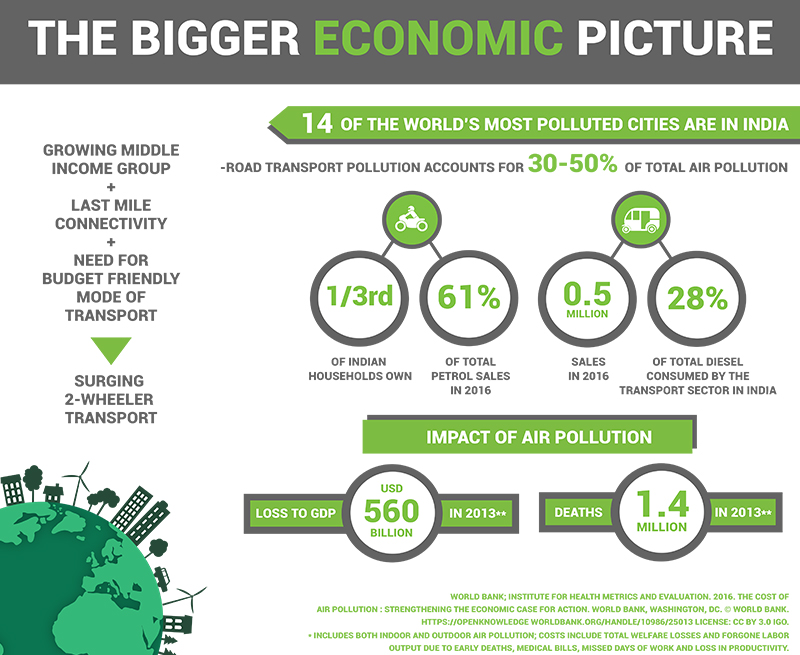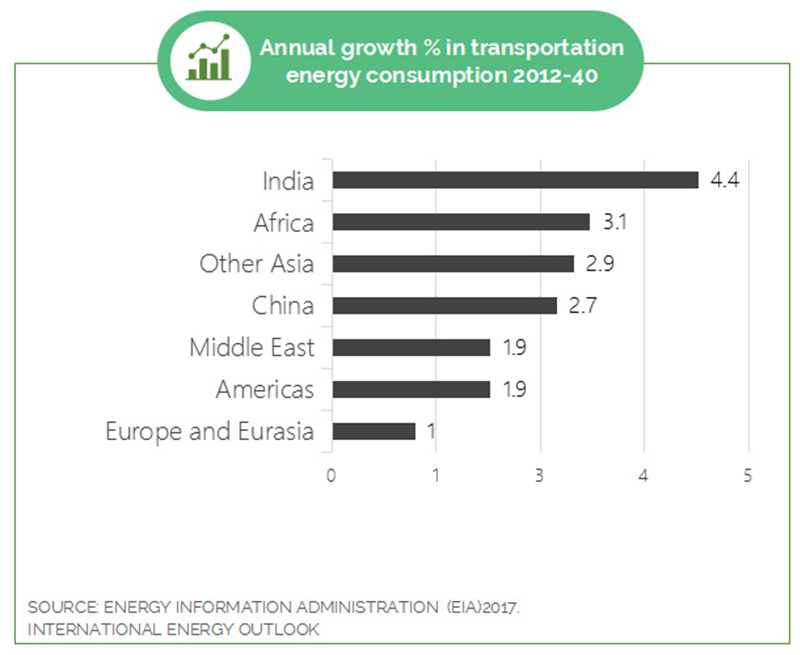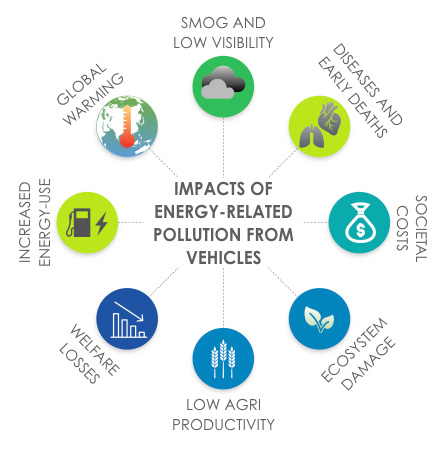Background
Fast-paced urbanisation and rising per capita incomes have seen an exponential increase in demand for mobility to move people and goods. This, in turn, has seen a sharp rise in ownership of motor vehicles – particularly 2 and 3 wheelers. Of the total petrol sales in India, two wheelers consume 61.42 percent of petrol sales (MoPNG, 2014). The surge in motorised vehicle ownership and energy intake comes with grave ramifications for environmental concerns: air pollution in Indian cities which already account for fourteen of the twenty most polluted cities in the world. All these factors impose heavy costs on the economic output and public health in the country. This will not only increase the burden on fuel sources and oil imports, but also impact greenhouse gas emissions that are critical for India to meet its NDC targets and the UN’s Sustainable Development Goals (SDGs 3, 7, 11, 13).


Several top-down policy initiatives and upcoming emissions standards, and labelling for energy efficient cars are gaining momentum. However, despite the sizeable share of two and three wheelers in petrol and diesel sales, and vehicle fleet in India, there is a gap in the efforts to address the emissions and energy consumption in these segments. There is a clear need for rating the environmental performance of these vehicles in India to educate and inform consumers, to enable them to keep in mind the impact their purchase decisions would have on the environmental resources such as air, leading to impacts on public health, and rise in carbon emissions and associated impacts on ecosystem and global warming levels.

There are several international precedents of environmental rating and consumer information programs for vehicles such as in the United States (ACEEE’s Green Score), Australia (Green Vehicle Guide), Belgium (Eco-Score), the United Kingdom (Green Car Rating), Eco Vehicles Rating (Mexico). No environmental economics based framework has been created to rate the environmental impacts of emissions and efficiency in two and three wheelers in India.
Mission of the Green Vehicle Rating
Green Vehicle Rating (GVR) for 2 and 3 Wheelers will create evidence-based awareness in consumers and shift their demand towards greener variants that rely on low emissions technology and high fuel economy. GVR allows consumers to identify the cleanest and most economically sensible vehicle models from an available pool, gives consumers web based access to easy to understand information – in monetary terms – to inform their purchase decisions, and see the costs and benefits of owning greener vehicles. In its current phase, GVR focuses on plant to wheel approach.This approach considers both upstream emissions (limited to fuel production, and distribution) and tailpipe emissions (GHGs and air pollutants) due to combustion of fossil fuels.

What is Green Vehicle Rating (GVR)?
Green Vehicle Rating serves as a consumer information tool that identifies high to low performing vehicle models, in two and three-wheeler categories, in terms of the negative impacts of GHG emissions and criteria pollutants. Along with a comparative analysis of vehicle models, the GVR shows the external costs of pollution – both GHGs and criteria pollutants. GVR broadly serves three functions:
- To find rating of vehicle models based on their environmental performance
- To inform/ educate the buyers about the health and environmental costs of vehicular emissions
- To inform the buyers about real cost of owning the vehicle
Did you check for the Form 22 while purchasing your vehicle?
 What is Form 22?
What is Form 22?
- Form 22 is a ‘Road Worthiness Certificate’
- Issued by motor vehicle manufacturers for every vehicle model
- As per the Central Motor Vehicle Rules, 1989 (CMVR) of Ministry of Road Transport and Highways (MoRTH).
 Why should you check Form 22?
Why should you check Form 22?
It shows the pollutant levels (gm/km) of vehicles to help your purchase decision:
- Carbon Monoxide (CO)
- Hydrocarbons (HC)
- Nitrogen Oxides (NOx)
- Non-Methane HC released
- Particulate Matter (PM) – only for diesel vehicles
 Where can you find the Form 22?
Where can you find the Form 22?
- Available with auto dealers
- Consumers should check prior to purchasing vehicles
- Also used for registering the vehicle with the Regional Transportation Office (RTO).
Benefits of Green Vehicle Rating (GVR)

Consumers
- Understandable information -> comparative rating of vehicles
- Expands the common notion of cost of owning a vehicle
- Provides health and environmental costs of vehicles in ₹/km
- Simplifies emissions data for inclusion in purchase decisions
Government
- Catalyses a well-informed consumer base
- Helps grow the share of efficient and less polluting vehicles
- Integrates government intent and auto market capabilities
- Facilitates research on cost-benefit of environmental regulations for vehicles
Automakers
- Puts spot light on high performers for consumer knowledge
- Highlights the costs and benefits of top selling models
- Symmetric information -> coordinated policy actions
- Catalyses willingness to pay for cleaner vehicles and fuel
